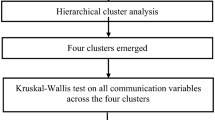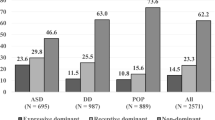Abstract
Findings from a longitudinal study of language acquisition in a group of autistic children are presented. Six autistic subjects and six children with Down syndrome, matched on age and MLU at the start of the study, were followed over a period of between 12 and 26 months. Language samples were collected in the children's homes while they interacted with their mothers. Samples of 100 spontaneous child utterances from the transcripts were analyzed using the following measures: MLU, Index of Productive Syntax, lexical diversity, and form class distribution. The results indicate that the majority of these autistic children followed the same general developmental path as the Down syndrome children in this study, and normal children reported in the literature, in the acquisition of grammatical and lexical aspects of language, and confirm previous findings suggesting that autism does not involve a fundamental impairment in formal aspects of language.
Similar content being viewed by others
References
Ball, J. (1978).A pragmatic analysis of autistic children's language with respect to aphasic and normal language development. Unpublished doctoral dissertation, Melbourne University, Australia.
Bartolucci, G., & Pierce, S. (1977). A preliminary comparison of phonological development in autistic, normal and mentally retarded subjects.British Journal of Disorders of Communication, 12, 137–147.
Bartolucci, G., Pierce, S., Streiner, D., & Eppel, P. T. (1976). Phonological investigation of verbal autistic and mentally retarded subjects.Journal of Autism and Childhood Schizophernia, 6, 303–316.
Bates, E., Bretherton, I., & Snyder, L. (1988).From first words to grammar. New York: Cambridge University Press.
Bernard-Opitz, V. (1982). Pragmatic analysis of trhe communicative behavior of an autistic child.Journal of Speech and Hearing Disorders, 47, 99–109.
Bloom, L., Lightbown, P., & Hood, L. (1975). Structure and variation in child language.Monographs of the Society for Research in Child Development, 40(Serial No. 160).
Boucher, J. (1976). Articulation in early childhood autism.Journal of Autism and Childhood Schizophrenia, 6, 297–302.
Brown, R., (1973).A first language. Cambridge, MA: Harvard University Press.
Cantwell, D., Baker, L., & Rutter, M. (1978). A comparative study of infantile autism and specific developmental receptive language disorder: IV. Analysis of syntax and language function.Journal of Child Psychology and Psychiatry, 19, 351–362.
Cohen, D. J., Paul, R., & Volkmar, F. (1986). Issues in the classification of pervasive and other developmental disorders: Toward DSM-IV.Journal of the American Academy of Child Psychiatry, 25, 213–220.
Cohen, D. J., Paul, R., & Volkmar, F. R. (1987). Issues in classification of pervasive developmental disorders and associated conditions. In D. J. Cohen & A. M. Donnellan (Eds.),Handbook of autism and pervasive developmental disorders (pp. 20–40). New York: Wiley.
Cunningham, M. A. (1966). A five-year study of the language of an autistic child.Journal of Child Psychology and Psychiatry, 7, 143–154.
Curcio, F., & Paccia, J. (1987). Conversations with autistic children: Contingent relationships between features of adult input and children's response adequacy.Journal of Autism and Developmental Disorders, 17, 81–93.
Denckla, M. B. (1966). New diagnostic criteria for autism and related behavioral disorders-Guidelines for research protocols.Journal of the American Academy of Child Psychiatry, 25, 221–224.
Dooley, J. (1976).Language acquisition and Down's syndrome: A study of early semantics and syntax. Unpublished doctoral dissertation, Harvard University, Cambridge, MA.
Fay, D., & Mermelstein, R. (1982). Language in infantile autism. In S. Rosenberg (Ed.),Handbook of applied psycholinguistics (pp. 393–428). Hillsdale, NJ: Erlbaum.
Fowler, A. (1984).Language acquisition of Down's syndrome children: Production and comprehension. Unpublished doctoral dissertation, University of Pennsylvania, Philadephia.
Fowler, A. (1986, October).Maturational determinants and constraints in rate of language growth in children with Down syndrome. Paper presented at the Boston University Conference on Language Development, Boston.
Hobson, P. (1989). Beyond cognition: A theory of autism. In G. Dawson (Ed.),Autism: New directions of diagnosis, nature, and treatment (pp. 22–48). New York: Guilford.
Kanner, L. (1946) Irrelevant and metaphorical language in early infantile autism.American Journal of Psychiatry, 103, 242–246.
Layton, T. I., and Baker, P. S. (1981). Description of semantic-syntactic relations in an autistic child.Jouranl of Autism and Developmental Disorders, 11, 385–399.
McCarthy, D. A. (1930).The language development of the preschool child. Minneapolis: University of Minnesota Press.
Menyuk, P., & Quill, K. (1985). Semantic problems in autistic children. In Schopler, E. & Mesibov, G. (Eds.),Communication problems in autism (pp. 127–145). New York: Plenum Press.
Mermelstein, R. (1983, October).The relationship between syntactical and pragmatic development in autistic, retarded, and normal children. Paper presented at the Eighth Annual Boston University Conference on Language Development, Boston.
Miller, J., & Chapman, R. (1981). The relation between age and mean length of utterances in morphemes.Journal of Speech and Hearing Research, 24, 154–161.
Miller, J., & Chapman, R. (1985).Systematic analysis of language transcripts: User's guide. Madison: University of Wisconsin Language Analysis Laboratory.
Nelson, K. (1975). The nominal shift in semantic-syntactic development.Cognitive Psychology, 7, 461–479.
Paul, R. (1987). Communication. In D. J. Cohen & A. M. Donnellan (Eds.),Handbook of autism and pervasive developmental disorders (pp. 61–84). New York: Wiley.
Paul, R., & Cohen, D. J. (1984). Responses to contingent queries in adults with mental retardation and pervasive developmental disorders.Applied Psycholinguistics, 5, 349–357.
Peters, A. (1983).The units of language acquisition. New York: Cambridge University Press.
Pierce, S., & Bartolucci, G. (1977). A syntactic investigation of verbal autistic, mentally retarded and normal children.Journal of Autism and Childhood Schizophrenia, 7, 121–134.
Pronovost, W., Wakstein, M. P., & Wakstein, D. J. (1966). A longitudinal study of speech behavior and language comprehension of fourteen children diagnosed atypical or autistic.Exceptional Children, 33, 19–26.
Rondal, J. (1978). Maternal speech to normal and Down's syndrome children matched for mean length of utterance.Monographs of the Association of Mental Deficiency, 3, 193–265.
Rondal, J. A., Ghiotto, M., Bredart, S., & Bachelet, J. F. (1987). Age-relation, reliability and grammatical validity of measures of utterance length.Journal of Child Language, 14, 433–446.
Rutter, M. (1978). Diagnosis and definition. In M. Rutter & E. Schopler (Eds.),Autism: A reappraisal of concepts and treatment (pp. 1–25). New York: Plenum Press.
Rutter, M., Greenfield, D., & Lockyer, L. (1967). A five to fifteen-year follow-up study of infantile psychosis: II. Social and behavioral outcome.British Journal of Psychiatry, 113, 1183–1199.
Scarborough, H. (1985, April).Measuring syntactic development: The Index of Productive Syntax. Paper presented at the Society of Research in Child Development, Toronto, Canada.
Scarborough, H., & Dobrich, W. (1985, April).Does stage V last until age five? Evidence from normal and language delayed children. Paper presented to the New York Child Language Group, New York.
Simon, N. (1975). Echolalic speech in childhood autism: Consideration of possible underlying loci of brain damage.Archives of General Psychiatry, 32, 1439–1446.
Swisher, L. & Demetras, M. J. (1985). The expressive language characteristics of autistic children compared with mentally retarded or specific language-impaired children. In E. Schopler & G. Mesibov (Eds.),Communication problems in autism (pp. 147–162). New York: Plenum Press.
Tager-Flusberg, H. (1982). Pragmatic development and its implications for social interaction in autistic children. In D. Park (Ed.),Proceedings of the international symposium for research in autism (pp. 103–108). Washington D.C.: National Society for Autistic Children.
Tager-Flusberg, H. (1985). The conceptual basis for referential word meaning in children with autism.Child Development, 56, 1167–1178.
Tager-Flusberg, H. (1986). Constraints on the representation of word meaning: Evidence from autistic and mentally retarded children. In S. A. Kuczaj & M. Barrett (Eds.),The development of word meaning (pp. 139–166). New York: Springer-Verlag.
Tager-Flusberg, H. (1989a). A psycholinguistic perspective on language development in the autistic child. In G. Dawson (Ed.),Autism: New directions on diagnosis, nature, and treatment (pp. 92–115). New York: Guilford.
Tager-Flusberg, H. (1989b, March).The development of questions in autistic and Down syndrome children. Paper presented at The Gatlinburg Conference on Theory and Research in Mental Retardation and Developmental Disabilities, Gatlinburg, TN.
Wetherby, A., & Prutting, C. (1984). Profiles of communicative and cognitive-social abilities in autistic children.Journal of Speech and Hearing Research, 27, 364–377.
Wolf, S., & Chess, S. (1965). An analysis of the language of fourteen schizophrenic children.Journal of Child Psychology and Psychiatry, 6, 29–41.
Author information
Authors and Affiliations
Additional information
This research was generously supported by a grant from the National Institute of Child Health and Human Development (RO1 HD 18833). We extend our sincere thanks to the children and their families who participated in this study.
Rights and permissions
About this article
Cite this article
Tager-Flusberg, H., Calkins, S., Nolin, T. et al. A longitudinal study of language acquisition in autistic and down syndrome children. J Autism Dev Disord 20, 1–21 (1990). https://doi.org/10.1007/BF02206853
Issue Date:
DOI: https://doi.org/10.1007/BF02206853




